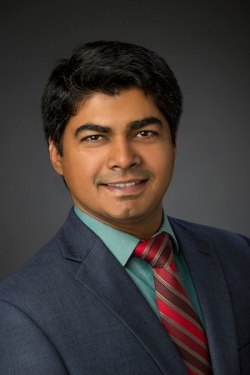Siddharth Misra, assistant professor at the University of Oklahoma Mewbourne College of Earth and Energy, is a 2018 winner of the Early Career Research Program award from the U.S. Department of Energy.
Now in its ninth year, the Early Career Research Program is designed to bolster the nation’s scientific workforce by providing support to exceptional researchers during the crucial early career years, when many scientists do their most formative work.
As a winner of the award, Misra will receive a minimum of $150,000 per year for five years to fund his research and salary.
“Dr. Misra is the first faculty member at the university to receive this prestigious award. I am very proud of Siddharth for receiving this recognition so early in his career and am confident his game-changing research will continue to garner the attention of the scientific community,” said Mike Stice, dean of the Mewbourne College.
Misra’s research aims to better map crack clusters and fracture networks in the porous rocks buried beneath the earth’s crust. It is knowledge crucial to geologists, petroleum engineers and other scientists.
“Along with standard fracturing that occurs in these subsurface rocks, some porous rocks undergo what is called a brittle process,” said Misra. “These rocks show no outward evidence that they under significant stress until they catastrophically break. When this happens, it can lead to the tragedies that so often fill our television screens: earthquakes, tsunamis, rockslides and other natural disasters.”
Current methods of mapping the subsurface rock are in their early stages and use sonic, acoustic and pressure tools – a sort of underground sonar. However, the process is made difficult by dozens of variables including temperature shifts, moisture changes, nearby fault activity, thermal exposure and the properties of the rocks themselves. It is a process that yields data fraught with errors.
Misra plans to overcome these challenges by developing machine learning algorithms to better interpret results of the mapping data. This will provide accurate information needed to build two-dimensional maps that will track the evolution of crack clusters and fracture networks. This may help scientists distinguish cracks and fractures that are benign, and cracks and fractures at risk of a sudden break because of a brittle process.
His project will generate open-source, machine learning software and high-quality educational material for college students. He also plans to develop educational resources for the public, specifically on how the cracks and fractures evolve beneath the earth and how those subsurface transformations can be monitored using machine learning techniques.
The research work is aligned with the DOE Geosciences Research Division’s grand vision of understanding, predicting and controlling subsurface fractures, and developing improved understanding of geophysical signatures of geochemical and geophysical processes of interest in the context of fractured rocks for the improvement of human lives, energy availability and the natural environment.
To learn more about the award, visit https://science.energy.gov/early-career.
The OU Mewbourne College of Earth and Energy is home to the Mewbourne School of Petroleum and Geological Engineering, the ConocoPhillips School of Geology and Geophysics and the Oklahoma Geological Survey. With a history that spans more than a century, the Mewbourne College provides leading earth sciences education and research, and has a key service mission to investigate Oklahoma’s water, mineral and energy resources.


